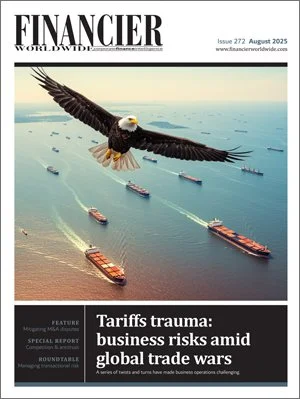Mitigating M&A disputes
August 2025 | FEATURE | MERGERS & ACQUISITIONS
Financier Worldwide Magazine
M&A activity has remained relatively resilient in recent years, despite ongoing geopolitical uncertainty. Although deal volume declined slightly in 2024 compared to previous years, there is a sense of cautious optimism in the market. This positive sentiment is underpinned by the stabilisation of global inflation, lower interest rates, robust capital markets in certain jurisdictions, and improving confidence around valuations.
While macroeconomic uncertainty – in no small part driven by tariff increases and other US policy measures – continues to dampen some deal activity, many corporates and private equity firms are actively pursuing transactions. The latter part of 2025 is expected to see a resurgence in dealmaking, contingent on greater clarity regarding global tariff developments and broader macroeconomic trends. The Trump administration’s economic policies – including tax reforms, interest rate strategies and antitrust enforcement – alongside challenges such as foreign exchange volatility, rising tensions with China and the strategic use of tariffs in trade negotiations, may not only complicate M&A activity but also increase the likelihood of deal-related disputes.
As with any business transaction, the risk of costly and disruptive disputes is significant. These disputes can arise at virtually any stage of the deal process: during the pre-signing phase, due to alleged breaches of confidentiality in non-disclosure agreements, exclusivity violations or disputes over letters of intent or term sheets; between signing and completion, where issues often relate to conditions precedent or conduct of business obligations; and post-completion, where breaches of warranties and indemnities, misrepresentations or disagreements over price adjustments are common.
According to the BRG M&A Disputes Report 2025, the financial services sector experienced a notable increase in disputes during 2024, largely due to the lingering effects of the 2023 banking crisis and heightened antitrust scrutiny. This trend is expected to continue into 2025 and beyond, particularly as deal volumes rise and regulatory frameworks evolve. Regulatory intervention was also a major driver of disputes in 2024, with governments closely examining large and cross-border transactions for antitrust and foreign investment risks.
The report found that 78 percent of respondents observed an increase in disputes in 2024 compared to 2023. Of these, 54 percent attributed the disputes primarily to financial or operational performance issues. Around one-third cited government interventions, including regulatory and compliance pressures, as key contributors to the rise in disputes. Additionally, 29 percent pointed to foreign investment scrutiny, while 28 percent identified tax policy as a contributing factor.
Regulatory bodies and courts have taken a more assertive stance, blocking several high-profile deals. Notable examples include the JetBlue-Spirit Airlines merger and the Kroger-Albertsons grocery deal, both of which faced significant regulatory hurdles and ultimately devolved into disputes. In January 2025, the US Department of Justice filed a lawsuit to block Hewlett Packard’s proposed $14bn acquisition of artificial intelligence firm Juniper Networks, marking one of the first major regulatory interventions of the year.
“Generally, the regulatory environment has been more and more tense,” believes Karolina Rozycka, counsel at Clifford Chance. “Enforcement and antitrust regulation remain a concern for M&A activities, especially for large transactions involving major companies. Regulatory bodies are increasingly vigilant about preventing things like monopolistic practices and ensuring competitive markets.”
“Clearly defined valuation methodologies, purchase price adjustment mechanisms and put/call option clauses can significantly reduce the risk of post-completion disputes.”
In response to these challenges, dealmakers must proactively manage financial risk through carefully negotiated deal terms and seek innovative ways to extract value from transactions.
Trending sources of M&A disputes
There are numerous reasons why disputes may arise in M&A, and increasingly, these are being driven by factors such as environmental, social and governance (ESG) concerns, the rise of artificial intelligence (AI), and misaligned valuations – particularly in high-value transactions.
ESG issues are especially significant, remaining a central focus in deals across many jurisdictions. These factors are attracting growing regulatory scrutiny, and the increasing political and investor pressure surrounding ESG means that disputes are likely to emerge in any ESG-focused transaction. Dealmakers are facing a broad range of ESG-related challenges, including claims related to sale terms, accusations of greenwashing, data privacy concerns and supply chain issues such as compliance with modern slavery legislation. The absence of standardised ESG metrics and requirements is expected to heighten dispute exposure in the future. For global businesses, navigating varying ESG standards across jurisdictions adds further complexity. There is no universal approach to ESG compliance, which in itself can be a source of contention and potential disputes.
According to the BRG report, among respondents who cited ESG as a factor in dispute activity over the past year, just over half (51 percent) identified claims related to sale terms as a key issue. Perceptions of greenwashing and unexpected costs arising in the later stages of green energy projects were each cited by 43 percent of respondents. Data privacy – classified under governance – ranked fourth among ESG-related dispute triggers. Social factors followed closely, including disputes over employee benefits, equal employment opportunities and fair or living wages.
Disputes related to the energy transition are also becoming more common. These may arise if sellers’ representations and warranties regarding green practices prove inaccurate, potentially leading to accusations of greenwashing. Shareholder activism can further fuel disputes, particularly when new shareholders demand divestment of certain assets or the implementation of specific policies.
Another growing area of concern is the integration of digital assets and blockchain technologies into M&A transactions. As companies increasingly acquire or merge with firms operating in the digital finance or crypto space, questions around asset ownership, regulatory classification and valuation methodologies are becoming more contentious. The lack of consistent legal frameworks across jurisdictions for digital assets can lead to post-deal uncertainty and legal challenges. Additionally, cyber security breaches discovered after closing can trigger claims of misrepresentation or breach of warranty, especially if the target company failed to disclose known vulnerabilities.
Macroeconomic conditions, digital assets, talent and technology are also influencing dispute volumes. The transformative impact of AI – and the hype surrounding it – is another emerging source of M&A disputes. While AI can significantly enhance efficiency and accuracy in due diligence and financial modelling, overreliance on AI introduces risks. AI systems may overlook critical issues or fail to detect red flags that a human expert would identify. It may also generate flawed financial projections due to poor-quality data or incorrect assumptions. Such errors can lead to disputes if significant risks are discovered post-closing or if valuation disagreements arise due to inaccurate forecasts.
Dispute drivers vary across regions. In Europe, the Middle East and Africa, regulation and compliance were top concerns in 2024, as EU regulators adopted a more assertive stance on antitrust and ESG matters. In the Asia-Pacific region, geopolitical tensions – particularly between the US and China – were the second most cited cause of disputes, reflecting concerns over reciprocal tariffs and the potential for a trade war.
In North America, financial and operational performance were the leading causes of disputes, likely due to the complexity of navigating US federal, state, local and cross-border tax regimes. Tax policies were the second most frequently cited factor.
Cultural issues also warrant careful consideration, particularly after a deal closes. Cultural clashes can disrupt integration and lead to disputes, potentially jeopardising the success of the transaction. Buyers should leverage robust governance and compliance programmes to align and integrate the target company’s culture, thereby reducing the risk of inheriting significant post-close issues. It is not enough to conduct a cultural assessment after closing; companies must also be mindful of the evolving cultural trajectory of the merged entity. Designing and implementing a cultural framework that reflects the new organisation can foster a more cohesive environment and reduce the risk of future misconduct or fraud.
Planning for the worst and drafting with precision
Disputes can be costly, time-consuming and value-destructive for the parties involved. As such, companies must have contingency plans in place to prevent disputes where possible, or at the very least, to mitigate the damage they may cause.
One of the most critical measures a company can adopt is establishing a clear dispute resolution strategy. While various mechanisms are available, arbitration is increasingly being chosen as the preferred forum for resolving M&A disputes. Although both parties in an M&A transaction share a common interest in ensuring a successful outcome, they must also protect their interests in the event the deal does not proceed as planned. Careful drafting of the transaction agreement can help minimise the risk of disputes and ensure that, if they do arise, they are resolved in a way that aligns with the parties’ expectations. Legal practitioners must therefore pay close attention to the drafting of key provisions and anticipate potential sources of conflict.
In today’s corporate takeover environment, securing shareholder support is essential. For prospective bidders, the success of a deal often depends on building a strong shareholder consensus, which may involve obtaining irrevocable commitments from major investors or acquiring significant shareholdings before launching a formal bid.
Given the current climate, buyers are well advised to expand their due diligence efforts beyond traditional practices, with particular attention to emerging risks associated with ESG and AI.
Comprehensive warranties and indemnities insurance has become a vital tool, offering protection against liabilities. However, it is not a substitute for thorough due diligence. Instead, it should complement due diligence efforts, helping to address any gaps in coverage through additional contractual safeguards.
Another important consideration is the use of earn-out provisions and contingent pricing mechanisms, which can help bridge valuation gaps between buyers and sellers. These clauses, however, must be drafted with precision to avoid ambiguity and future disagreements. Disputes often arise when performance targets are not clearly defined or when there is a lack of transparency in how financial metrics are calculated. Including detailed definitions, audit rights and dispute resolution procedures within these clauses can significantly reduce the likelihood of conflict. Additionally, parties should consider incorporating material adverse change clauses to address unforeseen events that could impact the transaction. These clauses must be carefully tailored to reflect the specific risks of the deal and the industry in which the target operates.
The precise drafting of key deal terms is also essential. Clearly defined valuation methodologies, purchase price adjustment mechanisms and put/call option clauses can significantly reduce the risk of post-completion disputes. Companies should also engage dispute resolution lawyers during the negotiation phase. These specialists can review key documents and offer insights into commonly disputed clauses and high-risk areas.
Dispute resolution clauses are particularly important and should be carefully drafted to avoid complications in bringing claims or enforcing decisions. Arbitration remains the preferred method for resolving cross-border M&A disputes, as it allows parties to avoid the risks associated with local courts, ensures confidentiality and provides a neutral forum. Moreover, decisions arising from arbitral proceedings are generally easier to enforce internationally.
Anticipating conflict
Disputes will inevitably arise at various stages of M&A transactions, and parties must be prepared for all eventualities. It is essential that companies remain alert to the increasingly assertive approaches taken by antitrust authorities and foreign direct investment regulators. Organisations should anticipate potential regulatory challenges before signing a deal. Equally, careful consideration must be given to deal terms that allocate and mitigate the risks associated with delays or failures to obtain approval, while also creating incentives for both parties to complete the transaction.
M&A transactions will continue to be a preferred strategy for many companies seeking to drive growth and create value. However, in today’s challenging dealmaking environment, it is crucial that organisations take appropriate precautions to safeguard both themselves and the success of their transactions wherever possible.
© Financier Worldwide
BY
Richard Summerfield


